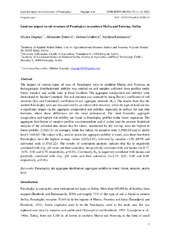Prikaz osnovnih podataka o dokumentu
Land use impact on soil structure of Pseudogleys in southern Mačva and Pocerina, Serbia
| dc.creator | Dugonjić, Mladen | |
| dc.creator | Đorđević, Aleksandar | |
| dc.creator | Golubović, Slađana | |
| dc.creator | Radmanović, Svjetlana | |
| dc.date.accessioned | 2024-01-11T13:09:41Z | |
| dc.date.available | 2024-01-11T13:09:41Z | |
| dc.date.issued | 2022 | |
| dc.identifier.issn | 2560-4279 | |
| dc.identifier.uri | http://aspace.agrif.bg.ac.rs/handle/123456789/6776 | |
| dc.description.abstract | The impact of various types of uses of Pseudogley soils in southern Mačva and Pocerina on theiraggregate distributionand stability was studied on soil samples collected from profiles under forest, meadow and arable land, at three localities. The aggregate composition and stability were determined by Savinov’smethod. The soil structure was assessed by using Revut’s coefficient of soil structure (Ks) and Vershinin’s coefficient of soil aggregate structure (KA). The results show that the studied Pseudogley soils are characterized by an unfavorable structure, while the type of land use has a significant impact on the aggregate composition and stability, especially in surface Ah and Ahp horizons, where these differences are the most pronounced. The most favorable aggregate composition and highest wet-stability are found in Pseudogley profiles under forest vegetation. The aggregate distribution of meadow profiles was intermediate and of arable land the poorest. Statistical analysis of the collected data shows that Ks values, determined by dry sieving, were the highest in forest profiles (2.261.21 on average), while the values for meadow were 1.591.09 and of arable land 1.140.62. The values of KA, used to assess the aggregate stability to water, also show that forest Pseudogleys have the highest average values (2.051.03), followed by meadow (1.96 0.99) and cultivated soils (1.931.22). The results of correlation analysis indicate that Ks is negatively correlated with clay, pH value and base saturation, but positively correlated with soil humus (r=-0.77, -0.70, -0.81 and 0.79, respectively, p<0.01). Conversely, KA is negatively correlated with humus and positively correlated with clay, pH value and base saturation (r=-0.21, 0.82, 0.69 and 0.69, respectively, p<0.01). | sr |
| dc.language.iso | en | sr |
| dc.publisher | Srpsko društvo za proučavanje zemljišta | sr |
| dc.relation | info:eu-repo/grantAgreement/MESTD/inst-2020/200116/RS// | sr |
| dc.rights | openAccess | sr |
| dc.rights.uri | https://creativecommons.org/licenses/by-sa/4.0/ | |
| dc.source | ZEMLJIŠTE I BILJKA | sr |
| dc.subject | Pseudogley | sr |
| dc.subject | dry aggregate distribution | sr |
| dc.subject | aggregate stability to water | sr |
| dc.subject | forest | sr |
| dc.subject | meadow | sr |
| dc.subject | arable land | sr |
| dc.title | Land use impact on soil structure of Pseudogleys in southern Mačva and Pocerina, Serbia | sr |
| dc.type | article | sr |
| dc.rights.license | BY-SA | sr |
| dc.citation.epage | 14 | |
| dc.citation.issue | 1 | |
| dc.citation.spage | 1 | |
| dc.citation.volume | 71 | |
| dc.identifier.doi | 10.5937/ZemBilj2201001D | |
| dc.identifier.fulltext | http://aspace.agrif.bg.ac.rs/bitstream/id/25832/bitstream_25832.pdf | |
| dc.type.version | publishedVersion | sr |


